See also
- Blue Apron, an ingredient-and-recipe meal kit service
- Luxury tax apron, a feature of the NBA salary cap
An apron is a functional accessory that has been worn for thousands of years as a protective, fashionable, and/or ceremonial top layer.
Apron may also refer to:
Page most commonly refers to:

An apron is a garment that is worn over other clothing to cover the front of the body. The word comes from Old French napron meaning a small piece of cloth, however over time "a napron" became "an apron", through a linguistics process called rebracketing. It may have several purposes, typically as a functional accessory that protects clothes and skin from stains and marks. However, other types of aprons may be worn as a decoration, for hygienic reasons, as part of a uniform, or as protection from certain dangers such as acid, allergens or excessive heat. It can also be used at work stations to hold extra tools and pieces or protect from dust and unwanted materials.

A loincloth is a one-piece garment, either wrapped around itself or kept in place by a belt. It covers the genitals and sometimes the buttocks. Loincloths which are held up by belts or strings are specifically known as breechcloth or breechclout. Often, the flaps hang down in front and back.
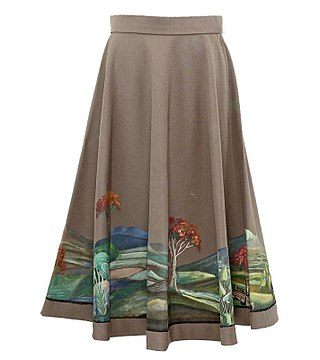
A skirt is the lower part of a dress or a separate outer garment that covers a person from the waist downwards.

Québec City Jean Lesage International Airport, also known as Jean Lesage International Airport, is the primary airport serving Quebec City, Canada. Designated as an international airport by Transport Canada, it is located eleven kilometres west-southwest of the city. In 2022, it was the 12th-busiest airport in Canada, with 1,174,321 passengers. More than 10 airlines offer 360 weekly flights to destinations across Canada, the United States, Central America, Mexico, the Caribbean and Europe.

Sidesaddle riding is a form of equestrianism that uses a type of saddle which allows female riders to sit aside rather than astride an equine. Sitting aside dates back to antiquity and developed in European countries in the Middle Ages as a way for women in skirts to ride a horse in a modest fashion while also wearing fine clothing. It has retained a specialty niche even in the modern world.

In theatre and performing arts, the stage is a designated space for the performance of productions. The stage serves as a space for actors or performers and a focal point for the audience. As an architectural feature, the stage may consist of a platform or series of platforms. In some cases, these may be temporary or adjustable but in theaters and other buildings devoted to such productions, the stage is often a permanent feature.

A dirndl is a feminine dress which originated in German-speaking areas of the Alps. It is traditionally worn by women and girls in Austria, Bavaria, Liechtenstein, Switzerland and Alpine regions of Italy. A dirndl consists of a close-fitting bodice featuring a low neckline, a blouse worn under the bodice, a wide high-waisted skirt and an apron.

A pinafore is a sleeveless garment worn as an apron.
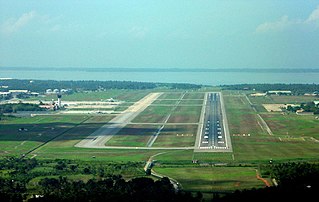
Bandaranaike International Airport (BIA) (Sinhala: බණ්ඩාරනායක ජාත්යන්තර ගුවන්තොටුපළ, romanized: Bandāranāyaka Jātyantara Guvantoṭupaḷa; Tamil: பண்டாரநாயக்க சர்வதேச விமான நிலையம், romanized: Paṇṭāranāyakka Carvatēca Vimāṉa Nilaiyam) (commonly known as Colombo International Airport, Colombo–Bandaranaike and locally as Katunayake Airport) (IATA: CMB, ICAO: VCBI) is the main international airport serving Sri Lanka. It is named after former Prime Minister S. W. R. D. Bandaranaike (1899–1959) and is located in a suburb of Negombo, 32.5 kilometres (20+1⁄4 miles) north of the nation's longstanding capital and commercial center, Colombo. It is administered by Airport and Aviation Services (Sri Lanka) Ltd and serves as the hub of SriLankan Airlines, the national carrier of Sri Lanka, and domestic carrier Cinnamon Air. The other airport serving the city of Colombo is Ratmalana International Airport.

The airport apron, apron, flight line, ramp, or tarmac is the area of an airport where aircraft are parked, unloaded or loaded, refueled, boarded, or maintained. Although the use of the apron is covered by regulations, such as lighting on vehicles, it is typically more accessible to users than the runway or taxiway. However, the apron is not usually open to the general public, and a permit may be required to gain access. An apron's designated areas for aircraft parking are called aircraft stands.

Serbian traditional clothing, also called as Serbian national costume or Serbian dress, refers to the traditional clothing worn by Serbs living in Serbia, Croatia, Bosnia and Herzegovina, Montenegro, and the extended Serbian diaspora communities in Austria, Australia, Bulgaria, Canada, France, Germany, Greece, Hungary, North Macedonia, Romania, Russia, Slovenia, United States, etc. Like any traditional dress of a nation or culture, it has been lost to the advent of urbanization, industrialization, and the growing market of international clothing trends. The wide range of regional folk costumes show influence from historical Austrian, Hungarian, German, Italian, and Ottoman Turkish presence. Nonetheless, the costumes are still a pinnacle part of Serbian folk culture. From the 19th century and onwards, Serbs have adopted western-styled clothing. This change has started in larger settlements such as cities and towns, although it was not uncommon to see rural women in traditional working costumes all the way until the end of President Josip Broz Tito's term. Today, these national costumes are only worn by some elderly in rural areas but are most often worn with connection to special events and celebrations, mostly at ethnic festivals, religious and national holidays, weddings, tourist attractions, and by dancing groups who dance the traditional Serbian kolo, or circle dance.
A Valance is a decorative apron used to conceal mechanical or structural framework for aesthetic purposes.
A back closure is a means for fastening a garment at the rear, such as with a zipper, hooks-and-eyes or buttons. Back closures were once common on Western female clothing, but have recently become less so, especially on female casual and business attire. They continue, however, to be widely used in underwear, formal wear and specialized clothing. Back closures are also common in garments for infants and toddlers.
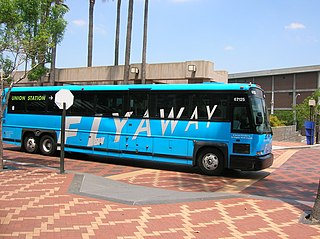
An airport bus, or airport shuttle bus or airport shuttle or Shuttle Bus is a bus used to transport people to and from, or within airports. These vehicles will usually be equipped with larger luggage space, and incorporate special branding. They are also commonly painted with bright colours to stand out among other airport vehicles and to be easily seen by the crews of taxiing aircraft when negotiating the aprons.
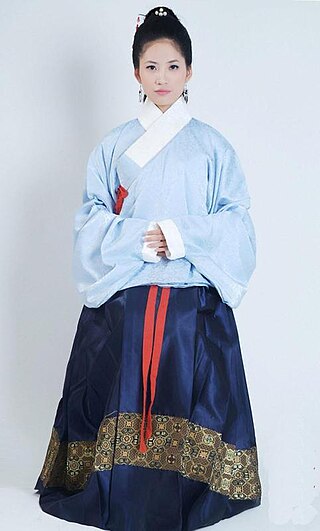
Ruqun is a set of attire in Hanfu which consists of a short jacket typically called ru worn under a long Chinese skirt called qun. However, when use as a general term, ruqun can broadly describe a set of attire which consists of a separated upper garment and a wrap-around lower skirt, or yichang, in which yi means the "upper garment" and the chang means the "lower garment". In a broad sense, ruqun can include the shanqun and aoqun in its definition.

Croatian national costume, also called as Croatian traditional clothing or Croatian dress, refers to the traditional clothing worn by Croats living in Croatia, Bosnia and Herzegovina, Serbia, with smaller communities in Hungary, Austria, Montenegro, and Romania. Since today Croats wear Western-style clothing on a daily basis, the national costumes are most often worn with connection to special events and celebrations, mostly at ethnic festivals, religious holidays, weddings, and by dancing groups who dance the traditional Croatian kolo, or circle dance.

Zaju chuishao fu, also called Guiyi, and sometimes referred as "Swallow-tailed Hems and Flying Ribbons clothing" or "swallow tail" clothing for short in English, is a form of set of attire in hanfu which was worn by Chinese women. The zaju chuishao fu can be traced back to the pre-Han period and appears to have originated the sandi of the Zhou dynasty; it then became popular during the Han, Cao Wei, Jin and Northern and Southern dynasties. It was a common form of aristocratic costumes in the Han and Wei dynasties and was also a style of formal attire for elite women. The zaju chuishao fu can be further divided into two categories of clothing style based on its cut and construction: the guipao, and the guichang.

Mamianqun, also known as mamianzhequn, sometimes simply referred as 'apron', a generic term in English to refer to any Chinese-style skirt, or 'paired apron' in English although they are not aprons as defined in the dictionary, is a type of qun, a traditional Chinese skirt worn by the Han Chinese women as lower garment item in Hanfu and is one of the main representatives of ancient Chinese-style skirts. It originated in the Song and Liao dynasties and became popular due to its functionality and its aesthetics style. It continued to be worn in the Yuan, Ming, and Qing dynasties where it was a typical style of skirt for women and was favoured for its unique aesthetic style and functionality. Following the fall of the Qing dynasty, the mamianqun continued to be worn in the Republic of China, and only disappeared in the 1920s and 1930s following the increased popularity of the cheongsam. As a type of xifu, Chinese opera costumes, the mamianqun maintains its long tradition and continues to be worn nowadays. In the 21st century, the mamianqun regained popularity with the emergence of the Hanfu movement. The mamianqun has experienced various fashion changes throughout history. It was typically paired with ku, Chinese trousers and Chinese jackets, typically either the ao or gua.
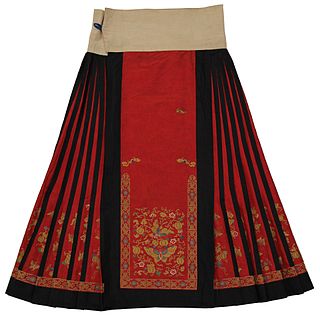
Qun, referred as chang prior to the Han dynasty, chang and xiachang, and sometimes referred as apron in English even though they are not apron as defined in the English dictionary, is a generic term which refers to the Chinese skirts used in Hanfu, especially those worn as part of ruqun, and in Xifu. The qun and its predecessor, the chang, along with the upper garment called yi and the trousers called ku, are all indigenous clothing of the Zhongyuan, which conformed to the fashion style of the Chinese civilization in ancient times. Both the qun and the chang, were both typically in the form of a wrap-around skirt like an apron. However, throughout Chinese history, the chang eventually evolved into the qun; and the qun evolved in diverse shapes, styles, and construction throughout the succeeding dynasties. The qun continued to exist even in the Republic of China. Several forms of ancient-style qun regained popularity in the 21st century following the Hanfu movement; this also inspired the development of new styles of qun with modern aesthetics and shapes.